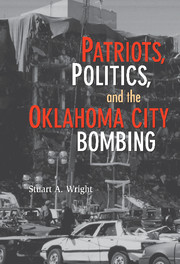Book contents
- Frontmatter
- Contents
- List of Figures and Tables
- Preface and Acknowledgments
- 1 CODICIL TO A PATRIOT PROFILE
- 2 PATRIOTS, POLITICAL PROCESS, AND SOCIAL MOVEMENTS
- 3 THE HISTORICAL CONTEXT OF PATRIOT INSURGENCY
- 4 THE FARM CRISIS, THREAT ATTRIBUTION, AND PATRIOT MOBILIZATION
- 5 STATE MOBILIZATION: BUILDING A TRAJECTORY OF CONTENTION
- 6 THE GUN RIGHTS NETWORK AND NASCENT PATRIOTS: RISE OF A THREAT SPIRAL
- 7 MOVEMENT-STATE ATTRIBUTIONS OF WAR: RUBY RIDGE AND WACO
- 8 PATRIOT INSURGENCY AND THE OKLAHOMA CITY BOMBING
- 9 AFTER OKLAHOMA CITY: PATRIOT DEMOBILIZATION AND DECLINE
- References
- Index
6 - THE GUN RIGHTS NETWORK AND NASCENT PATRIOTS: RISE OF A THREAT SPIRAL
Published online by Cambridge University Press: 05 June 2012
- Frontmatter
- Contents
- List of Figures and Tables
- Preface and Acknowledgments
- 1 CODICIL TO A PATRIOT PROFILE
- 2 PATRIOTS, POLITICAL PROCESS, AND SOCIAL MOVEMENTS
- 3 THE HISTORICAL CONTEXT OF PATRIOT INSURGENCY
- 4 THE FARM CRISIS, THREAT ATTRIBUTION, AND PATRIOT MOBILIZATION
- 5 STATE MOBILIZATION: BUILDING A TRAJECTORY OF CONTENTION
- 6 THE GUN RIGHTS NETWORK AND NASCENT PATRIOTS: RISE OF A THREAT SPIRAL
- 7 MOVEMENT-STATE ATTRIBUTIONS OF WAR: RUBY RIDGE AND WACO
- 8 PATRIOT INSURGENCY AND THE OKLAHOMA CITY BOMBING
- 9 AFTER OKLAHOMA CITY: PATRIOT DEMOBILIZATION AND DECLINE
- References
- Index
Summary
One of the reasons often cited by state officials for the rapid expansion of paramilitary policing in the War on Crime and Drugs was the pressing need to counter the flow of dangerous weapons into the hands of criminals, gangs, and drug traffickers. Because criminals were obtaining more powerful and deadly weapons, it was claimed, police were forced to respond to this challenge by adopting more military-like tactics and weaponry in crime fighting. The rise of violent crime in the streets of impoverished inner-city neighborhoods during the economically troubled eighties bolstered the tough rhetoric of warfare by officials in fashioning crime control policy. By the early 1990s, the state was intensifying strategies to interdict firearms laws to reduce illegal sales and distribution to criminals and terrorists. Heightened attention to interdicting illegal weapons coincided with the state's efforts to move toward greater integration of police and military forces as the post–Cold War era was providing new opportunities and resources for the domestic war, or what Kraska (2001c: 9) has dubbed “the new Cold War.”
In reaction to the state's shift in focus, Patriots and gun rights groups began to decry this new initiative as a threat and increasingly framed gun control efforts as signs of a “police state.” The emergent threat attribution impelled and inflamed Patriot actors, leading to the formation of new alliances with gun owners and the gun rights network based on shared fears about state disarmament.
- Type
- Chapter
- Information
- Patriots, Politics, and the Oklahoma City Bombing , pp. 114 - 138Publisher: Cambridge University PressPrint publication year: 2007

